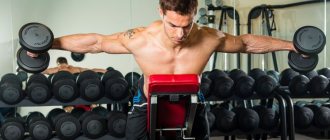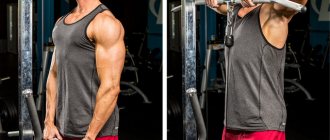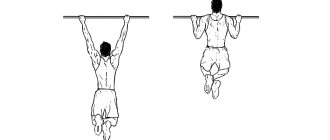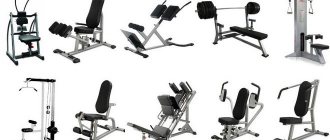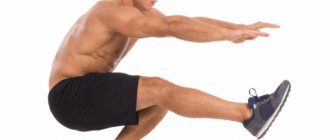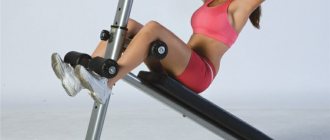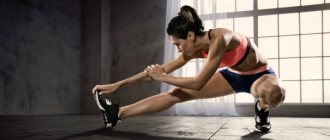Many people have heard about “chest day” or “leg day” and imagine working out in the gym exclusively this way: today you do one thing, tomorrow you do something else. This technique - splits - is often used in bodybuilding.
The Lifehacker Telegram channel contains only the best texts about technology, relationships, sports, cinema and much more. Subscribe!
Our Pinterest contains only the best texts about relationships, sports, cinema, health and much more. Subscribe!
However, beginners are advised to abandon splits and train the muscles of the entire body in one workout. This will allow you to work all muscle groups symmetrically and recover quickly.
How many approaches and repetitions to do
Beginners are advised to perform high repetitions with light weight. This approach provides:
- The rapid formation of the neuromuscular connection necessary to increase muscle mass.
- Active growth of muscle mass.
- No injuries from heavy weights.
To simplify the program, perform the same number of sets and reps for all exercises. Perform all of the exercises below for three sets of 10 reps unless otherwise noted.
IV. Decide on a set of exercises
Write down all the exercises you want to do during your workouts. Moreover, it is better to immediately sort them by muscle groups. If you do not have enough experience, then problems may arise with this due to basic ignorance of anatomy and biomechanics. Well, as a hint, you can look at the article: What exercises are basic. Or use MENU – EXERCISES. Where they are already sorted by body parts.
The amount of exercise can vary greatly depending on your goals and amount of training. Let's say, if you train 2 times a week to stay in shape using a combined method, then 10 basic exercises (5 per workout) will be enough for you. If you are actively losing weight with supersets of 5 workouts per week, then the number of exercises can be 40 or even more.
What should the warm-up be like?
Warm up before your workout.
- Joint warm-up: twirl your joints, bend and twist your body.
- Five minutes of light cardio: a gentle run on the treadmill, a session on the elliptical trainer, jumping rope.
If strength exercises are performed with a weight of more than 20 kilograms, warm-up approaches are necessary before them. You perform the exercise 3-5 times with an empty bar, and then add 10-20 kilograms.
For example, if you are doing back squats with a weight of 50 kilograms, the warm-up sets would be as follows: 20 x 3, 30 x 3, 40 x 3, one minute rest and the first set with the working weight.
The benefits of strength training for women
Lifting weights isn't just about shaping your body. It also has other benefits.
- You will become stronger. This is one of the first and most important effects of strength training that you will notice. And also, increasing the strength of your muscles does not require increasing the amount of muscle itself - which is exactly what many women worry about.
- You will improve the strength of your bones. This is especially important for women with high estrogen levels and low levels of bone strength. Strength training will significantly reduce your bones' tendency to break down.
- You will strengthen your connective tissue. This is the type of tissue that holds your muscles, joints and bones together, and if it gets stronger, it will reduce your chance of damaging them later in life.
- You will improve your mental health. And this is one of the best consequences of strength training. Anxiety, depression, mood swings – moderate, regular exercise will help combat all of this.
If you are new to sports or returning to exercise after a long break, then you may not understand where you need to start. The correct training schedule will depend on many factors: your age, level of training, goals and other individual characteristics of your body.
What exercises to do
By starting a workout with your abs, you tone them so they better support your core and prevent you from rounding your back in movements like deadlifts or back squats.
Press raises
Place your legs bent at the knees on the floor or place them on a hill so that the angle at the knee is 90 degrees, and put your hands behind your head. Perform three sets of 20 reps.
Leg raises
This exercise puts stress on the hip flexor muscles. Perform three sets of 20 reps.
Lie on the floor, place your arms along your body. Raise your legs bent at the knees so that your thigh is perpendicular to the floor. Lift your pelvis off the floor and push it up, then lower yourself and repeat.
Hyperextension
This exercise does double duty: it works the back extensor muscles, which help you support your back during deadlifts and squats, and it activates your glutes. The latter is especially important for people with sedentary jobs.
The exercise can be done on an incline hyperextension machine, where the body is positioned at an angle, on a Roman chair, where the body is parallel to the floor, or on a GHD.
Bend your body until it is parallel to the floor or slightly lower, and then straighten your back up. The deeper you bend down, the more your buttocks engage.
Back Squats
The exercise puts stress on the front of the thigh and buttocks.
To begin, experiment with the position of your legs and find out which position is most comfortable for you: wide, narrow, with your knees turned out strongly or just slightly to the sides.
While squatting, pay attention to your technique.
- The back should remain straight throughout the exercise. If it rounds at the bottom, your back muscles are not strong enough, take a lighter weight.
- Feet should not leave the floor.
- Squat through your full range: at least to parallel with the floor or slightly below.
Bench press
Pumps up the pectoral muscles, engages the triceps, shoulders and core muscles.
Lie down on a bench press bench with your legs wide apart and your feet flat on the floor. To determine your grip width, grab a barbell and lower it to your chest. At the bottom, your forearms should be perpendicular to the bar. Take the barbell, move it to a position above your chest, lower it until it touches your chest, and raise it again.
Here are a few features of the technique:
- If you use a medium grip, your wrists, elbows, and bar are all in the same plane.
- The feet are pressed firmly to the floor; do not place your feet on your toes.
- Do the movement in full amplitude, touching the bar to your chest.
Deadlift
Deadlifts work the hamstrings, glutes, and back extensors.
Walk up to the bar, position your feet so that the bar is above the laces of your sneakers, close to your shins. Grab the barbell a little further than shoulder-width apart and bend your knees. Lift the barbell with a straight back until the hip joint is fully extended.
Features of the technology:
- Keep your back straight, this will take the pressure off your lower back.
- Stand with your feet shoulder-width apart and turn your toes out 15-25 degrees.
- Raise the bar close to your shins, almost sliding over them (but, of course, not like in the GIF below).
Upper pulley to chest
This exercise targets the latissimus dorsi muscles.
Sit on the machine, grab the handle and pull it towards your chest. Perform the exercise using your back muscles, not your arms and shoulders.
Standing chest press
This exercise targets the shoulders, especially the front of them, and the pectoral muscles.
Grasp the barbell with an overhand grip, shoulder-width apart or slightly wider. Raise the barbell up, fully straighten your elbows at the extreme point and move your hands slightly back, behind your head.
Several features of the technology:
- The gaze is directed forward, do not raise your head behind the bar.
- When the bar passes in front of your head, do not lift your chin, but tilt your head back.
- Do not lean your body back while pressing.
Barbell curl
This is an isolated exercise for the biceps brachii.
Take the barbell with a reverse grip shoulder-width apart, lift it by bending your elbow, and lower it smoothly.
Features of the technology:
- To relieve the load on your lower back, slightly tilt your body forward.
- To protect your elbow joint, lower the weight smoothly and under control rather than throwing it down.
- You can shift the load on different heads of the biceps due to the position of the elbows (pulled your elbows back - you loaded the outer head of the biceps more, brought your elbows forward - you loaded the inner head of the biceps).
Bent-over dumbbell raises
This movement works the back of the shoulders.
Take dumbbells, bend down until parallel to the floor and spread your arms to the sides.
Peculiarities:
- Do not raise your shoulders up; they should be lowered to turn off the trapezius muscles.
- To increase the load on the rear deltoid muscles, slightly turn your hands with your little fingers up.
Extension of arms on a triceps block
Stand next to the upper block, grab the handle with a straight grip, slightly move your body forward, do not round your back. It is important to fix the entire shoulder girdle so that only your forearms move during the exercise.
Peculiarities:
- You can shift the load on different heads of the triceps by changing your grip (a forward grip pumps up the lateral head of the triceps, and a reverse grip pumps up the long head).
- The overhead pulldown with a rope handle allows you to spread your arms at the lowest point and turn your hands with your little fingers outward (this also allows you to better work the long head of the triceps).
Starting training in the gym
Professional athletes also often face a similar choice, but their program is much more complex and intense. In addition, they can always turn to their personal trainer for help or, using their accumulated knowledge, optimize existing techniques to suit their own needs and needs. They know their strengths and weaknesses and know how to listen to their own body. Experienced bodybuilders can either have a planned training plan for several months in advance, or improvise to vary their training.
This approach, unfortunately, is not suitable for beginners. When entering the gym, many people are simply lost and don’t know where to start training. It is best, of course, to seek help from a trainer and follow the recommendations that he gives. You can also ask the advice of pumped-up guys who visit the same gym. But, as practice shows, not all trainers are able to give truly worthwhile advice or create a training program. There are those who received their “title” by completing paid courses. Not all guys of impressive size have extensive training knowledge and skills. And here some will be lucky, and some will not.
How to diversify your workouts
| Movement from the program | Options for replacement |
| Press raises | Roman chair sit-ups, V-shaped sit-ups |
| Leg raises | Raising the knees to the chest while hanging on the horizontal bar, raising the legs to the horizontal bar |
| Squats | Lunges with a barbell on the back, sumo squats with a kettlebell or dumbbells |
| Bench press | Dumbbell flyes, push-ups, hummer presses |
| Deadlift | Leg bending on a lying machine, deadlift (deadlift on straight legs) |
| Upper pulley to chest | Bent-over barbell row, bent-over dumbbell row, bent-over T-bar row |
| Standing chest press | Standing Dumbbell Press |
| Barbell curl | Dumbbell biceps curl |
| Bent-over dumbbell raises | Raising arms on a machine (“reverse butterfly”) |
| Triceps pulley extension | French bench/standing press, reverse push-ups with elevated feet, dips |
Home workout program
You will find a breakdown of the exercises under the program.
The Lifehacker Telegram channel contains only the best texts about technology, relationships, sports, cinema and much more. Subscribe!
Our Pinterest contains only the best texts about relationships, sports, cinema, health and much more. Subscribe!
Monday
- Joint warm-up . Tilts and turns of the head, rotation of the shoulders, elbows and wrists, tilts of the body to the sides and forward, rotation of the pelvis, extension of the hip to the side, rotation of the knees and feet. Perform 10 rotations (tilts) in each direction. The entire warm-up will take no more than 5 minutes.
- Warming up (performed intensively):
- Jumping Jacks - 30 seconds;
- running in place - 30 seconds;
- jumping rope - 100 times.
- Power block:
- classic push-ups - three sets of 10 times;
- dumbbell press up - three sets of 15 times;
- Bent-over dumbbell rows - three sets of 10 times on each arm;
- squats - three sets of 20 times;
- raising the pelvis on one leg - three sets of 10 times on each leg;
- lifting the body on the press - three sets of 20 times;
- boat - 3 sets of 10 times;
- classic plank - hold for 30 seconds, three approaches.
- Stretching . Perform all stretching exercises for 30 seconds.
Tuesday
- Joint warm-up.
- Warming up
- Circuit training #1. Do the exercises at a measured pace, try not to stop and keep rest to a minimum. Perform six rounds of the following exercises:
- 5 push-ups;
- 10 press raises;
- 15 squats.
- Circuit training #2. This workout is performed for time using the Tabata protocol. You do as many exercises as you can in 20 seconds, then rest for 10 seconds. You need to complete six laps. That is, you set the timer for 3 minutes and start.
- burpee;
- rock climber;
- squats (first try jump squats, if you don’t have the strength to continue, do regular ones).
- Stretching.
Wednesday - rest
Thursday
- Joint warm-up.
- Warming up.
- Power block:
- reverse push-ups - three sets of 10 times;
- lunges - three sets of 10 times on each leg;
- standing dumbbell swings - three sets of 10 times;
- lifting the pelvis with support on a bench - three approaches of 10 times;
- Bent-over dumbbell raises - three sets of 10 reps;
- leg raises for abs - three sets of 20 times;
- boat - three sets of 10 times;
- classic plank → side plank to the right side → classic plank → side plank to the left side - hold each for 30 seconds.
- Stretching.
Friday
- Joint warm-up.
- Warming up
- Circuit training #1. Perform the exercises at a measured pace, try not to stop and keep rest to a minimum. Perform six rounds of the following exercises:
- 5 push-ups with wide arms;
- 5 reverse push-ups;
- 10 jump squats;
- 30 seconds plank + 30 seconds rest.
- Circuit training #2. You do as many exercises as you can in 30 seconds, then rest for 30 seconds. Do two circuits:
- burpee;
- jumping rope;
- rock climber;
- Jumping Jacks;
- alternating legs in a lunge.
- Stretching.
Saturday and Sunday
Rest and recover. You can do yoga or stretch.
VI. Determine the order of exercises
Next, you need to prescribe the order of performing the exercises, which also plays a big role. Especially when gaining weight. When losing weight - less, but still do not neglect this stage.
When gaining mass and/or strength , you can perform exercises in a block of 2–3 exercises one after another for one muscle group. Or you can alternate antagonist muscles (biceps - triceps, chest - back, etc.). In any case, at the end of the workout, you should maximally hammer exactly those muscles that you have planned for today.
Losing weight - here the “block” is not necessary and even harmful. You just need to alternate top and bottom. You can alternate antagonists. But, under no circumstances, not as a block. The load should jump from one muscle to another throughout the entire workout. This is the only way you can load your entire body.
Relief – you can either use a block or alternate antagonist muscles. In some cases, alternating top-bottom is suitable. But this, in my opinion, is a little unsuitable for the terrain.
Maintaining the achieved form is any option. Again, it depends on how you arrived at this form.

